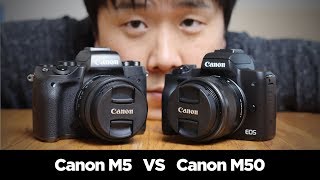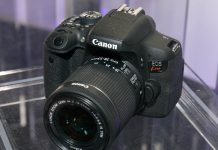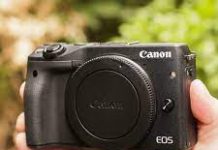Canon’s Mirrorless Cameras: EOS M5 vs M50
The rise in popularity of mirrorless cameras has led to fierce competition among manufacturers, and Canon has made significant contributions to this market. In this article, we will compare and contrast Canon’s EOS M5 and M50 models, focusing on their features, performance, and suitability for different photography needs.
Design and Ergonomics

When it comes to design and ergonomics, both the EOS M5 and M50 showcase Canon’s commitment to quality. The EOS M5 has a solid build quality with a magnesium alloy body, while the M50 features a slightly lighter polycarbonate construction. Both cameras have a compact size, with the M50 being slightly smaller and lighter than the M5.
In terms of handling, the EOS M5 offers a more substantial grip, providing a comfortable and secure hold. The control layout on both cameras is intuitive, with well-placed buttons and dials for easy access to settings. However, the EOS M5 has an advantage with its additional top-mounted LCD panel, which allows for quick monitoring of key settings.
Image Quality and Sensor Performance
Image quality is a crucial aspect to consider when comparing cameras, and sensor size and resolution play a significant role in this regard. The EOS M5 features a larger APS-C sensor with a resolution of 24.2 megapixels, while the M50 has a slightly smaller APS-C sensor with a resolution of 24.1 megapixels.
The larger sensor of the EOS M5 provides several advantages, including better low-light performance and improved dynamic range. It allows for capturing more detail and producing images with less noise in challenging lighting conditions. However, both cameras deliver excellent image quality, with accurate colors and impressive sharpness.
When it comes to ISO performance, both cameras offer a wide range, with the EOS M5 having a native range of 100-25600 (expandable up to 51200) and the M50 having a native range of 100-25600 (expandable up to 51200). Both cameras perform well at higher ISO settings, with minimal noise up to ISO 3200.
Autofocus and Performance
The autofocus systems of the EOS M5 and M50 are highly capable, making them suitable for various shooting scenarios. The EOS M5 boasts a Dual Pixel CMOS AF system with 49 autofocus points, covering a wide area of the frame. The M50, on the other hand, features an improved Dual Pixel CMOS AF system with 143 autofocus points, providing even more coverage.
Both cameras offer fast and accurate autofocus performance, allowing for quick subject acquisition and tracking. The EOS M5 performs admirably in continuous autofocus mode, ensuring sharp focus on moving subjects. The M50 takes it a step further with its Eye Detection AF, which automatically focuses on the subject’s eyes for portraits and ensures precise focus.
When it comes to burst shooting, the EOS M5 can capture up to 9 frames per second (fps) with continuous autofocus, while the M50 can shoot at 10 fps with continuous autofocus. Both cameras have decent buffer capacities, allowing for extended bursts before slowing down.
Video Capabilities
Both the EOS M5 and M50 offer impressive video recording capabilities, making them suitable for vloggers and videographers. The EOS M5 can record videos in Full HD resolution (1080p) at up to 60 frames per second (fps), while the M50 takes it a step further with the ability to shoot in 4K UHD resolution (2160p) at up to 24 fps.
When it comes to video autofocus, both cameras excel. The Dual Pixel CMOS AF system ensures smooth and accurate autofocus during video recording. The EOS M5 also offers touch autofocus, allowing you to tap on the screen to change the focus point while recording.
Image stabilization is crucial for handheld video recording, and both cameras have it covered. The EOS M5 features in-body 5-axis digital image stabilization, while the M50 offers a combination of in-body 3-axis digital image stabilization and lens-based stabilization (when using compatible lenses).
Additional video-related features include the presence of a microphone input and HDMI output for external audio and video recording. The EOS M5 also offers a headphone jack for monitoring audio during video capture, which is absent in the M50.
Connectivity and Features
Both the EOS M5 and M50 come equipped with various connectivity options, allowing for easy sharing and remote control. They feature built-in Wi-Fi and Bluetooth, enabling wireless transfer of images and remote control via a smartphone or tablet. NFC (Near near-field communication) is also available, allowing for quick pairing with compatible devices.
The EOS M5 and M50 both have a vari-angle touchscreen that can be tilted and rotated for shooting at various angles. This feature is particularly useful for vlogging and capturing creative perspectives. However, only the EOS M5 includes an electronic viewfinder (EVF), providing an alternative way to compose images in bright conditions.
When it comes to lens options, both cameras are compatible with Canon’s EF-M lenses, specifically designed for their mirrorless cameras. Additionally, with the use of an adapter, they can also utilize Canon’s extensive range of EF and EF-S lenses, providing users with a wide selection of lenses to choose from.
Each camera has its unique features. The EOS M5 stands out with its top-mounted LCD panel, which allows for quick access to key settings. On the other hand, the M50 boasts a fully articulating touchscreen, which is beneficial for shooting from different angles and for self-recording.
Price and Value for Money
When it comes to pricing, the EOS M5 is generally priced higher than the M50, reflecting its more advanced features and capabilities. However, it’s important to consider the overall value for money offered by each camera.
The EOS M5, with its robust build quality, advanced autofocus system, and additional features like the top-mounted LCD panel and headphone jack, is a great option for serious photographers and videographers who require top-notch performance. It is well-suited for professional use and offers excellent long-term investment potential.
On the other hand, the M50 provides a more affordable entry point into Canon’s mirrorless camera lineup. It offers a good balance of features, including 4K video recording, a vari-angle touchscreen, and improved autofocus performance. The M50 is ideal for enthusiasts, vloggers, and those looking for a versatile and compact camera.
Ultimately, the choice between the EOS M5 and M50 depends on individual needs, preferences, and budget. It’s important to consider the specific photography requirements and prioritize features accordingly.
FAQs
Are Canon EF lenses compatible with the EOS M5 and M50?
Yes, with the use of an adapter, both cameras can utilize Canon’s EF and EF-S lenses in addition to the EF-M lenses specifically designed for their mirrorless cameras.
What is the battery life of the EOS M5 and M50?
The EOS M5 and M50 offer decent battery life, allowing for several hundred shots on a single charge. However, it’s recommended to carry spare batteries for extended shooting sessions.
Do the EOS M5 and M50 have image stabilization?
Yes, both cameras feature image stabilization. The EOS M5 has in-body 5-axis digital image stabilization, while the M50 combines in-body 3-axis digital image stabilization with lens-based stabilization (with compatible lenses).
Will the cameras receive software updates to enhance their performance and add new features?
Canon regularly releases firmware updates for their cameras, including the EOS M5 and M50. These updates can improve performance, fix bugs, and sometimes even add new features. It’s recommended to check Canon’s official website for any available updates and follow the instructions provided to keep your camera up to date.
Can the EOS M5 and M50 shoot in RAW format?
Yes, both cameras offer the ability to capture images in RAW format, which allows for greater flexibility in post-processing and preserving the highest image quality.
Do the EOS M5 and M50 have built-in flash?
Yes, both cameras have a built-in pop-up flash, which can be useful for fill-in lighting or when shooting in low-light conditions. Additionally, they also have a hot shoe for attaching external flashes or other accessories.
Conclusion
The battle between Canon’s EOS M5 and M50 mirrorless cameras showcases the brand’s commitment to delivering high-quality imaging solutions. The EOS M5, with its robust build, advanced autofocus, and additional features, is ideal for professionals and serious enthusiasts seeking top-notch performance. On the other hand, the M50 offers a more affordable entry point without compromising on key features like 4K video recording and improved autofocus. It caters to the needs of enthusiasts, vloggers, and those looking for a compact and versatile camera.




